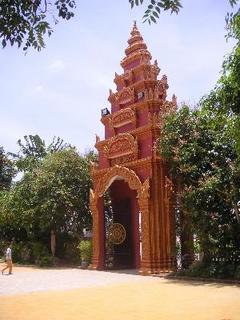

The stone carvings were especially intricate and complex. The Khmer architectural style is unlike any I have ever seen, reminescent of some Indian Buddhist structures but completely different than the temples in Vietnam. And the symbolism in the art is a rich blend of Buddhist, Brahmanistic (Hindu), and indigeneous Khmer elements. At Wat Ummalom, there are also many stupas (conical Buddhist reliquaries), lingas (phallic representations of the Brahman deity Shiva), and scenes from the Reamker (the Khmer version of the Indian Ramayama epic).

And it was great to see the wat on such a gorgeous day, as it has been raining a lot lately. When it rains in Phnom Penh, it really rains hard, and the streets flood temporarily. Once the rain stops, however, the weather is very pleasant and cool. Because didn't rain today, by noon it was very hot outside.

After seeing Wat Ummalom, I took a walk over to Wat Phnom, which is situated on the only hill in the city. The wat is surrounded by a public park, for both humans and monkeys.

The wat also has many stupas, but is more typically Buddhist in style, and there are even several areas which are devoted to a more Chinese religious theme. The main temple is decorated with scenes from the Buddha's mythological past lives, known as the jataka stories, in which he sacrifices himself for the benefit of other living beings, especially animals. The most famous jataka in Cambodia is that of Prince Vessantara, which is the archetype of generousity in the popular Buddhist tradition. I had never been in a Theravada Buddhist temple before, and I was suprised to both the similarities and differences to Mahayana temples I have visited elsewhere. Wat Phnom does not appear to have many monks, and its function as a wat is mostly ceremonial.
I have a lot to learn about Buddhism in Cambodia, both in terms of understanding how animistic and Brahmanistic elements have been incorporated into the tradition and in terms of understanding how the terror of Democratic Kampuchea (the Khmer Rouge) broke the continuity of Buddhist teaching in Cambodia.
1 comment:
Trent,
You're photography is fantastic. Compostion, lighting, etc.!
Yea, just thought you should add that to your skill set.
Ryan
Post a Comment